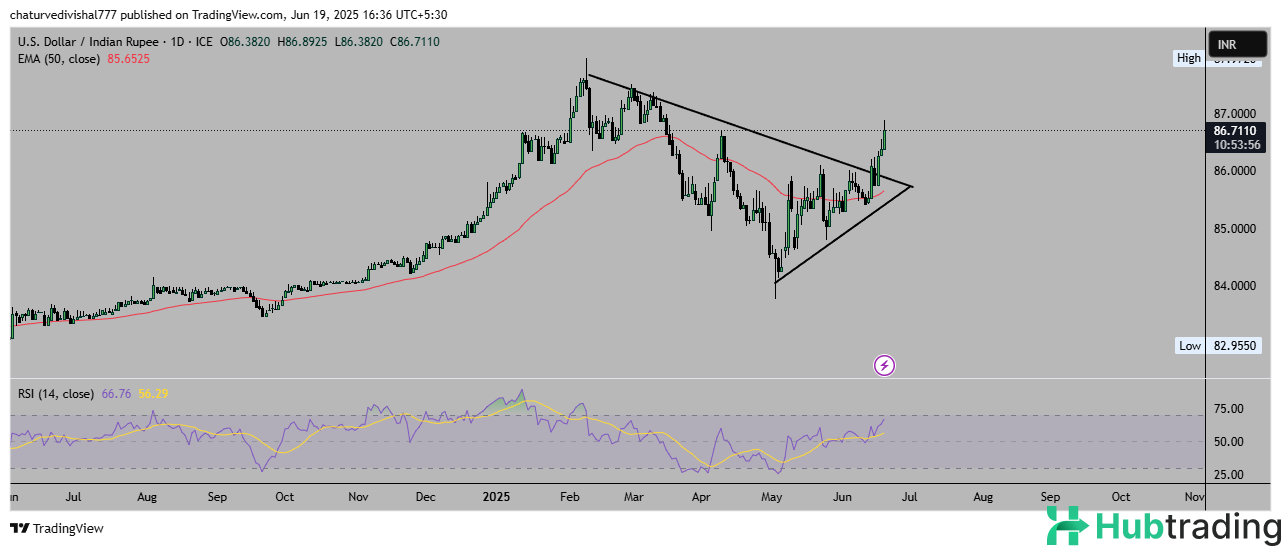-
The Indian Rupee weakens for a third straight session, falling to its lowest level against the US Dollar since mid-March.
-
The Israel–Iran conflict enters its seventh day, with reports suggesting the US is preparing for potential military action.
-
Brent and WTI crude prices surge over 20% in June, as persistent supply concerns drive oil markets higher.
The Indian Rupee (INR) continued its decline for a third consecutive session on Wednesday, falling to its lowest level in three months against the US Dollar (USD). The drop comes as intensifying tensions in the Middle East stoke fears of disrupted oil supply, driving Crude Oil prices higher and adding pressure to India’s widening import bill—an ongoing drag on the Rupee.
The USD/INR pair climbed to around ₹86.71, just below its intraday peak of ₹86.89 during European trading hours. Meanwhile, the US Dollar Index (DXY) held steady near 98.95, maintaining its strength after the Federal Reserve kept interest rates unchanged on Wednesday. The Fed’s cautious tone helped support the Greenback amid global uncertainty. However, with US markets closed on Thursday for the Juneteenth holiday, trading volumes remain thin, limiting short-term market moves until liquidity returns on Friday.
Geopolitical risks remain front and center as the Israel–Iran conflict enters its seventh day. Both sides have ramped up military operations—Israel continues to strike Iranian nuclear and military sites, while Iran has launched waves of ballistic missiles and drones at Israeli targets, including civilian hospitals.
The United States has increased its military presence in the region, deploying additional naval and air assets in a show of deterrence. Former President Donald Trump, while vocally supporting Israel’s strikes—calling them “excellent”—has sent mixed signals about possible direct US involvement. “I may do it. I may not do it. I mean, nobody knows what I'm going to do,” he stated, adding to the uncertainty surrounding future escalation.
With geopolitical tensions rising and oil prices surging over 20% this month, the Rupee remains vulnerable to further downside as markets brace for potential volatility ahead.
Market Movers: Indian Rupee Hits Three-Month Low as Oil Surges, Fed Holds Steady
- The Indian Rupee (INR) slipped to its weakest level since mid-March against the US Dollar on Thursday, weighed down by intensifying geopolitical tensions and rising crude oil prices. Risk sentiment deteriorated sharply after reports surfaced suggesting the United States is actively considering military action against Iran, further escalating the Israel–Iran conflict.
- Tensions surged midweek following a report by The Wall Street Journal, revealing that US President Donald Trump had privately approved potential military strikes on Iran, though he held back from issuing a final order to assess Iran’s willingness to curb its nuclear ambitions. Bloomberg added to the unease, reporting that US defense officials are already preparing for a near-term strike.
- This heightened risk of broader conflict has pushed oil prices sharply higher, with Brent crude futures last seen near $76 per barrel—up over 20% month-to-date. West Texas Intermediate (WTI) has similarly climbed, trading around $74 with a gain of roughly 22%. Despite subdued US trading due to the Juneteenth holiday, both benchmarks remain supported by supply concerns.
- Indian lawyer and political activist Prakash Ambedkar highlighted the inflationary impact of oil spikes, warning that rising crude prices compel Indian refiners to purchase more US dollars, thus weakening the Rupee and making imported fuel even more expensive in local currency terms. Ambedkar noted that this self-reinforcing cycle threatens to widen India’s current account deficit and strain the broader economy. He urged the government to cushion the impact by adjusting excise duties or offering fuel subsidies and called on the Reserve Bank of India (RBI) to intervene in the forex market to stabilize the Rupee.
- Economists estimate that every $10 increase in crude oil adds approximately 0.4% of GDP to India’s current account deficit—a figure that raises red flags amid already heightened external pressures.
- On the monetary policy front, the US Federal Reserve kept its benchmark interest rate steady at 4.25%–4.50% on Wednesday, as expected. Policymakers hinted at two possible rate cuts by year-end but stressed that future decisions will be driven by economic data and inflation trends.
- Fed Chair Jerome Powell struck a careful tone, noting that the central bank’s projections should not be taken as guarantees. “No one holds these rate paths with a great deal of conviction,” Powell said, reinforcing the Fed’s adaptive, data-driven stance. His comments helped support the US Dollar, adding additional pressure on emerging market currencies like the Rupee.
USD/INR Technical Outlook: Triangle Breakout Signals Further Upside
The USD/INR pair has broken out decisively from a multi-month symmetrical triangle pattern on the daily chart, confirming bullish momentum with a string of strong upside candles. The pair is now comfortably trading above the breakout region, with the 50-day Exponential Moving Average (EMA) near 85.65 acting as dynamic support.
The Relative Strength Index (RSI) on the daily timeframe is holding near 66, suggesting solid bullish momentum with room for further gains before approaching overbought territory. If the pair sustains this upward trajectory, a break above the key psychological resistance at 87.00 could open the door to the next target zone at 87.50–88.00.
On the downside, any retracement toward the 86.00–86.20 region may attract dip buyers, reinforcing the underlying uptrend and positioning the pair for further strength in the near term.






